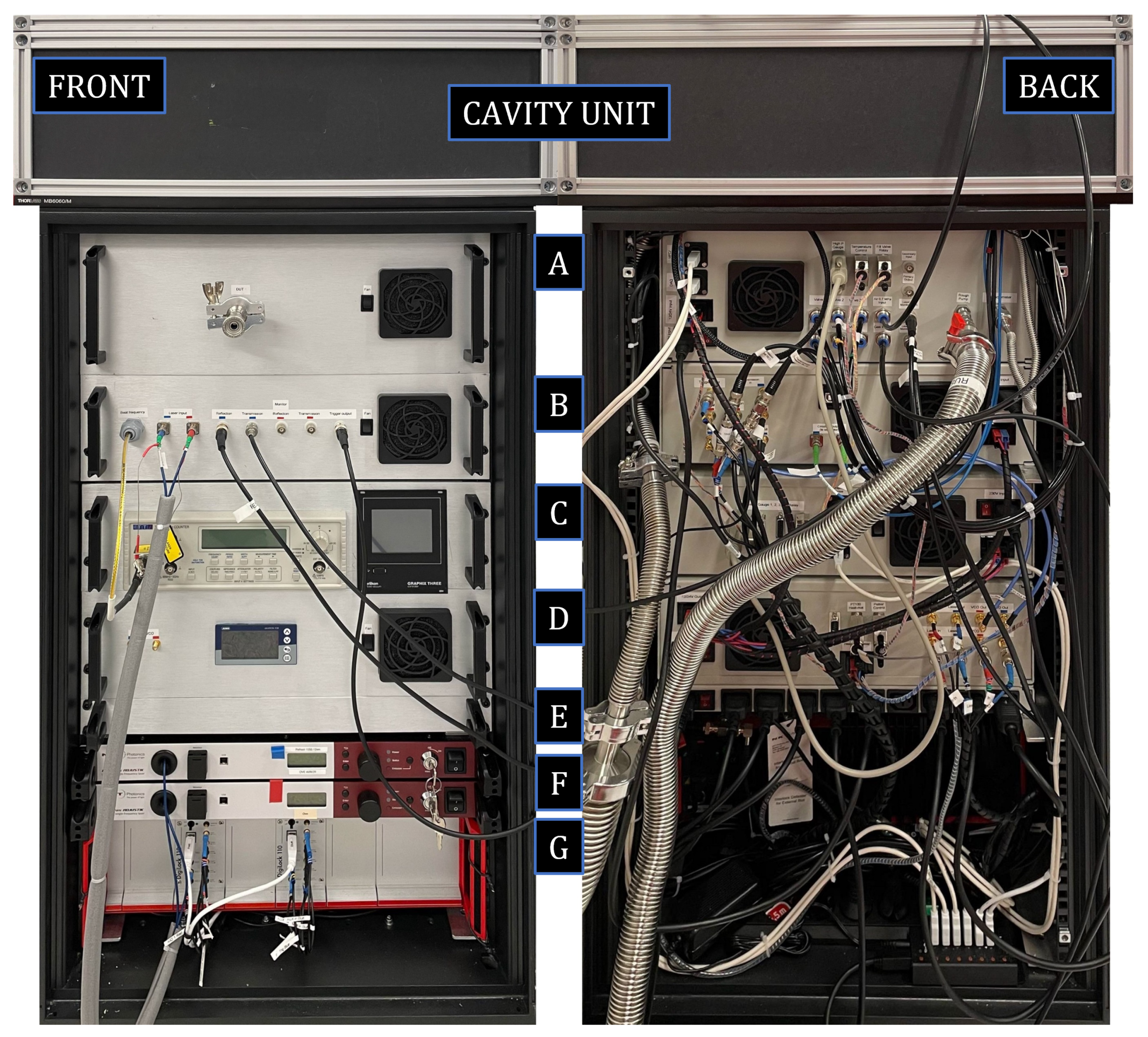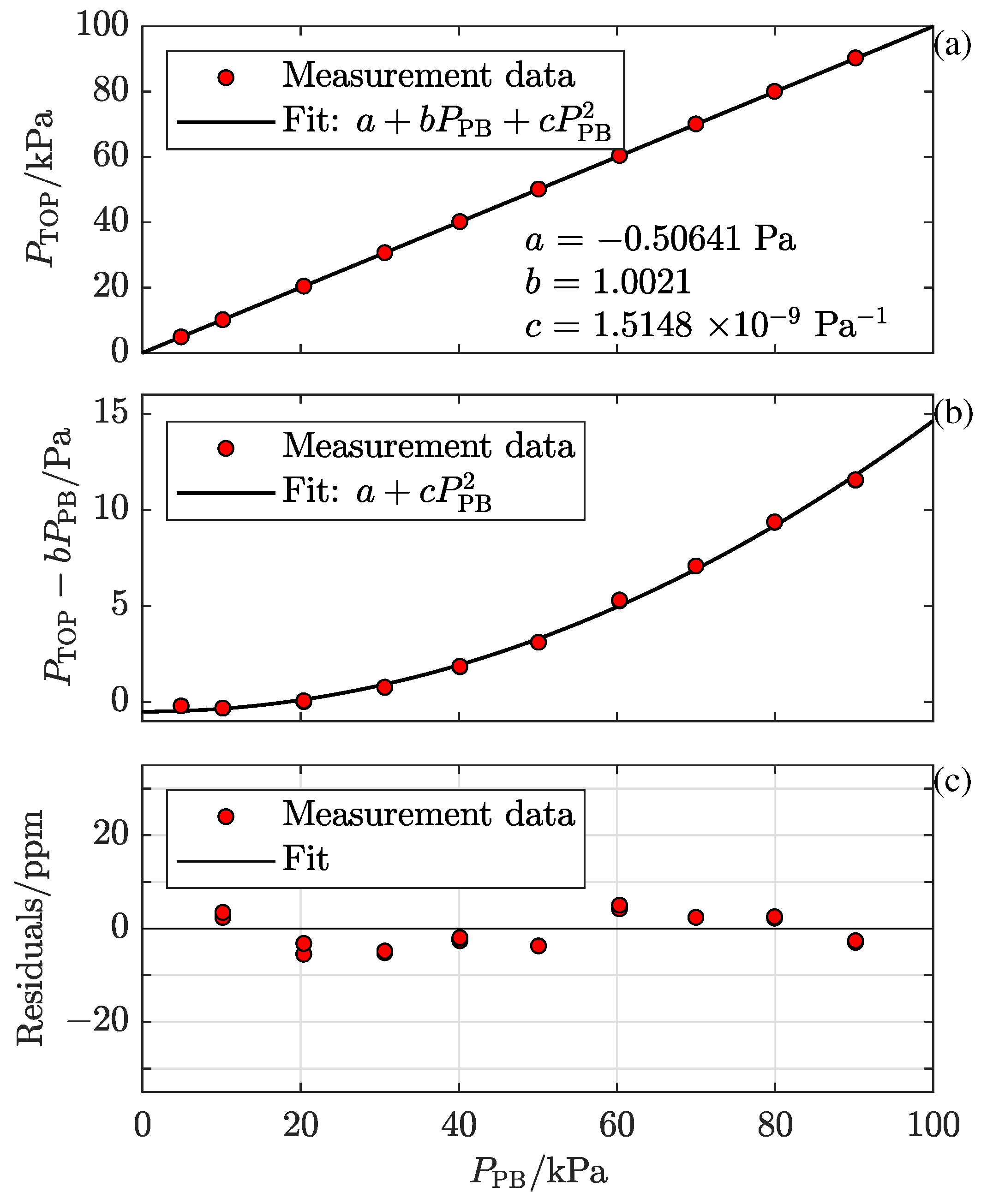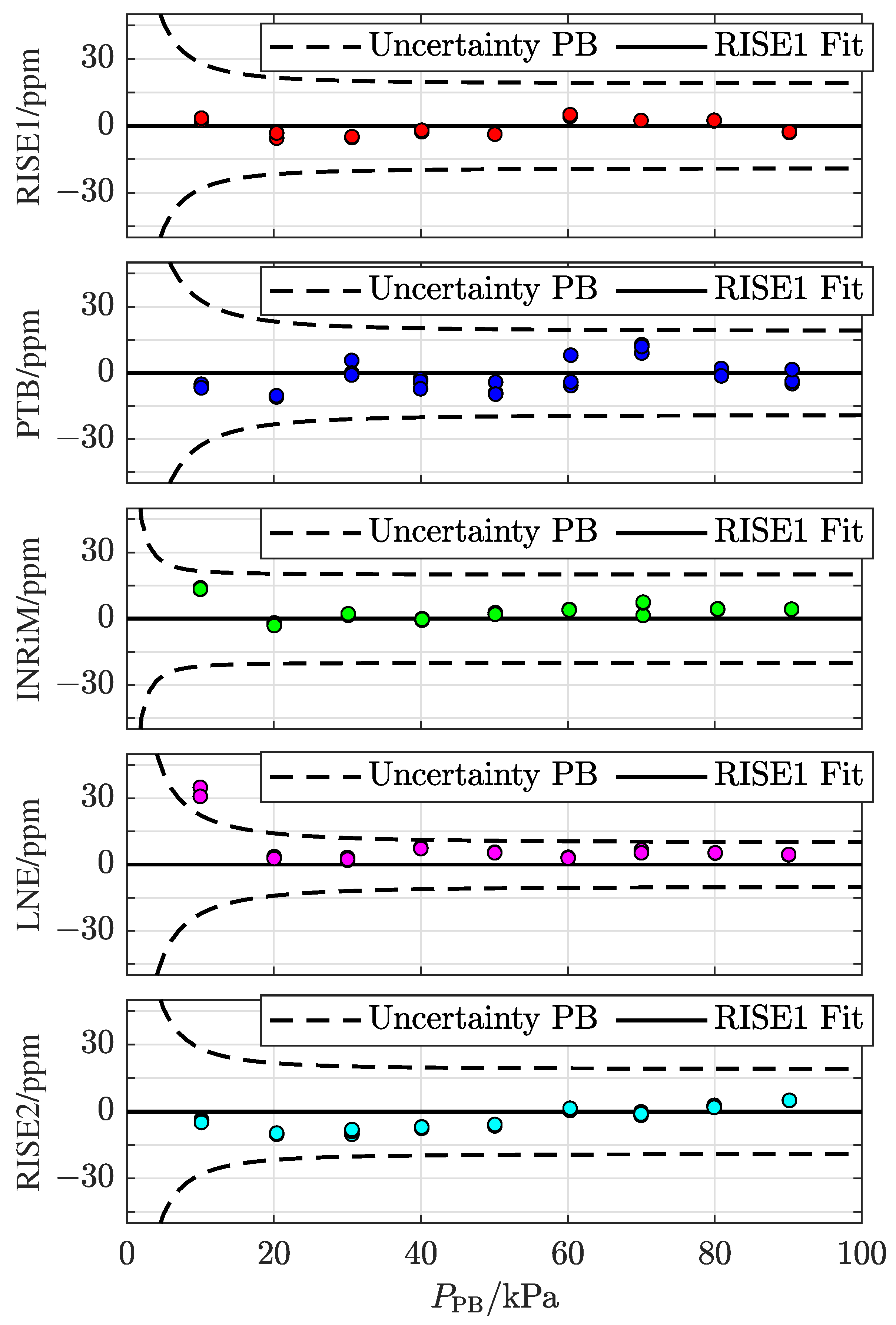Demonstration of a Transportable Fabry–Pérot Refractometer by a Ring-Type Comparison of Dead-Weight Pressure Balances at Four European National Metrology Institutes
Abstract
1. Introduction
2. Transportable Refractometer
- The system was designed to fit in a 120 cm high wheel-equipped 19-inch rack. This is obviously non-ideal in terms of stability; it would be preferable to place the system on a firm and stable surface, such as a rigid optical table. However, this overall design has the advantages that it makes it easy to move the refractometer within laboratories and, at the same time, minimizes the footprint of the system, which otherwise can be a problem at some visited laboratories. A picture of the front and back of the system is shown in Figure 1.
- The TOP assesses the temperature of the cavity by using two Pt-100 sensors whose outputs are assessed by a data acquisition (DAQ) system. This is in contrast to the stationary system that uses a thermocouple directly referred to an active gallium fixed-point cell. The reason for this downgrade in terms of accuracy is that the gallium cell adds unwanted complexity to the system that most notably increases the setup time and limits the measurement to certain time windows when the gallium is in its proper melting state. To ensure traceability, without the gallium fixed-point, an external temperature measurement device (Hart 1502A) and an accompanying calibrated Pt-100 probe was brought as hand luggage to each visit and used to calibrate the Pt-100 probes and the DAQ system of the TOP prior to each series of measurements. To evaluate the stability of the temperature assessment module, it was calibrated at RISE both before and after the measurement campaign. The discrepancy between these two calibrations was below the resolution of the instrument (1 mK), providing an estimated uncertainty limited by the resolution of the instrument of 2 ppm (see below).
3. Measurement Procedure
3.1. Establishment of Measurement Procedures
3.2. Day One—Unpacking, Setup, and Installation
3.3. Day Two—Optical Alignment, Control/Verification, and Stabilization
3.4. Day Three—Assessments
3.5. Day Four—Spare Day and Packing
3.6. Day Five—Spare Day for Packing
3.7. Packing—Preparation for Shipping
4. Measurements and Results
4.1. Initial Measurement and Characterization
4.2. The Ring Comparison
5. Conclusions
Author Contributions
Funding
Institutional Review Board Statement
Informed Consent Statement
Data Availability Statement
Acknowledgments
Conflicts of Interest
Abbreviations
| CNAM | Conservatoire National des Arts et Métiers |
| DAQ | Data acquisition system |
| DFPC | Dual-Fabry–Pérot cavity |
| DOEs | Degrees of equivalences |
| EMPIR | European Metrology Programme for Innovation and Research |
| FP | Fabry–Pérot |
| GAMOR | Gas modulation refractometry |
| INRiM | Istituto Nazionale di Ricerca Metrologica |
| KCRVs | Key comparison reference values |
| LNE-CNAM | Laboratoire Commun de Métrologie (CNAM) |
| NIM | National Institute of Metrology |
| NIST | National Institute of Standards and Technology |
| NMI | National Measurement Institute |
| ppm | parts per million |
| PTB | Physikalisch-Technische Bundesanstalt |
| RISE | Research Institutes of Sweden |
| SOP | Stationary optical pascal |
| TOP | Transportable optical pascal |
| UmU | Umeå University |
References
- Sutton, C.M. The pressure balance as an absolute pressure standard. Metrologia 1994, 30, 591–594. [Google Scholar] [CrossRef]
- Schmidt, J.W.; Jain, K.; Miiller, A.P.; Bowers, W.J.; Olson, D.A. Primary pressure standards based on dimensionally characterized piston/cylinder assemblies. Metrologia 2005, 43, 53–59. [Google Scholar] [CrossRef][Green Version]
- Semenoja, S.; Rantanen, M. Comparisons to establish a force-balanced piston gauge and a spinning rotor gauge as the new measurement standards of MIKES. Vacuum 2004, 73, 269–274. [Google Scholar] [CrossRef]
- Hendricks, J.; Olson, D. 1–15,000 Pa Absolute mode comparisons between the NIST ultrasonic interferometer manometers and non-rotating force-balanced piston gauges. Measurement 2010, 43, 664–674. [Google Scholar] [CrossRef]
- Ricker, J.; Hendricks, J.; Bock, T.; Dominik, K.; Kobata, T.; Torres, J.; Sadkovskaya, I. Final report on the key comparison CCM.P-K4.2012 in absolute pressure from 1 Pa to 10 kPa. Metrologia 2016, 54, 07002. [Google Scholar] [CrossRef] [PubMed]
- Jousten, K.; Hendricks, J.; Barker, D.; Douglas, K.; Eckel, S.; Egan, P.F.; Fedchak, J.; Flügge, J.; Gaiser, C.; Olson, D.; et al. Perspectives for a new realization of the pascal by optical methods. Metrologia 2017, 54, 146–161. [Google Scholar] [CrossRef]
- Andersson, M.; Eliasson, L.; Pendrill, L.R. Compressible Fabry-Pérot refractometer. Appl. Opt. 1987, 26, 4835–4840. [Google Scholar] [CrossRef]
- Egan, P.F.; Stone, J.A.; Hendricks, J.H.; Ricker, J.E.; Scace, G.E.; Strouse, G.F. Performance of a dual Fabry–Pérot cavity refractometer. Opt. Lett. 2015, 40, 3945–3948. [Google Scholar] [CrossRef]
- Mari, D.; Pisani, M.; Astrua, M.; Zucco, M.; Pasqualin, S.; Egidi, A.; Bertinetti, M.; Barbone, A. Realisation of an optical pressure standard by a multi-reflection interferometric technique. Measurement 2023, 211, 112693. [Google Scholar] [CrossRef]
- Takei, Y.; Arai, K.; Yoshida, H.; Bitou, Y.; Telada, S.; Kobata, T. Development of an optical pressure measurement system using an external cavity diode laser with a wide tunable frequency range. Measurement 2020, 151, 107090. [Google Scholar] [CrossRef]
- Silvestri, Z.; Bentouati, D.; Otal, P.; Wallerand, J.P. Towards an improved helium-based refractometer for pressure measurements. Acta IMEKO 2020, 9, 303. [Google Scholar] [CrossRef]
- Thakur, V.N.; Yadav, S.; Kumar, A. Realization of Quantum Pascal Using Natural Fundamental Physical Constants. MAPAN 2020, 35, 595. [Google Scholar] [CrossRef]
- Silander, I.; Forssén, C.; Zakrisson, J.; Zelan, M.; Axner, O. Optical realization of the Pascal—Characterization of two gas modulated refractometers. J. Vac. Sci. Technol. B 2021, 39, 044201. [Google Scholar] [CrossRef]
- Yang, Y.; Rubin, T.; Sun, J. Characterization of a vacuum pressure standard based on optical refractometry using nitrogen developed at NIM. Vacuum 2021, 194, 110598. [Google Scholar] [CrossRef]
- Mari, D.; Pisani, M.; Francese, C. Rayleigh scattering for pressure assessment. Meas. Sens. 2021, 18, 100253. [Google Scholar] [CrossRef]
- Gaiser, C.; Fellmuth, B.; Sabuga, W. Primary gas-pressure standard from electrical measurements and thermophysical ab initio calculations. Nat. Phys. 2020, 16, 177–180. [Google Scholar] [CrossRef]
- Rourke, P.M.; Gaiser, C.; Gao, B.; Ripa, D.M.; Moldover, M.R.; Pitre, L.; Underwood, R.J. Refractive-index gas thermometry. Metrologia 2019, 56, 032001. [Google Scholar] [CrossRef]
- Song, H.W.; Kim, J.H.; Kim, K.T.; Woo, S.Y. Preliminary results of KRISS optical pressure standard system. Meas. Sens. 2021, 18, 100169. [Google Scholar] [CrossRef]
- Stock, M.; Davis, R.; de Mirandés, E.; Milton, M.J.T. The revision of the SI—The result of three decades of progress in metrology. Metrologia 2019, 56, 022001, Corrigendum: The revision of the SI—The result of three decades of progress in metrology. Metrologia 2019, 56, 49502. [Google Scholar] [CrossRef]
- Buckingham, A.D.; Graham, C. The Density Dependence of the Refractivity of Gases. Proc. R. Soc. A 1974, 337, 275–291. [Google Scholar]
- Egan, P.F.; Stone, J.A.; Ricker, J.E.; Hendricks, J.H. Comparison measurements of low-pressure between a laser refractometer and ultrasonic manometer. Rev. Sci. Instrum. 2016, 87, 053113. [Google Scholar] [CrossRef] [PubMed]
- Forssén, C.; Silander, I.; Zakrisson, J.; Zelan, M.; Axner, O. The Short-Term Performances of Two Independent Gas Modulated Refractometers for Pressure Assessments. Sensors 2021, 21, 6272. [Google Scholar] [CrossRef] [PubMed]
- Silander, I.; Hausmaninger, T.; Zelan, M.; Axner, O. Gas modulation refractometry for high-precision assessment of pressure under non-temperature-stabilized conditions. J. Vac. Sci. Technol. A 2018, 36, 03E105. [Google Scholar] [CrossRef]
- Silander, I.; Forssén, C.; Zakrisson, J.; Zelan, M.; Axner, O. Invar-based refractometer for pressure assessments. Opt. Lett. 2020, 45, 2652–2655. [Google Scholar] [CrossRef]
- Forssén, C.; Silander, I.; Zakrisson, J.; Amer, E.; Szabo, D.; Bock, T.; Kussicke, A.; Rubin, T.; Mari, D.; Pasqualin, S.; et al. Circular Comparison of Conventional Pressure Standards Using a Transportable Optical Refractometer: Preparation and Transportation. In Proceedings of the 6th TC16 Conference on Pressure and Vacuum Measurement 2022, Cavtat-Dubrovnik, Croatia, 11–13 October 2022; Available online: https://www.imeko.org/publications/tc16-2022/IMEKO-TC16-2022-137.pdf (accessed on 21 September 2023).
- Zakrisson, J.; Silander, I.; Forssén, C.; Zelan, M.; Axner, O. Procedure for robust assessment of cavity deformation in Fabry–Pérot based refractometers. J. Vac. Sci. Technol. B 2020, 38, 054202. [Google Scholar] [CrossRef]
- BIPM; IEC; IFCC; ILAC; ISO; IUPAC; IUPAP; OIML. Evaluation of Measurement Data|Guide to the Expression of Uncertainty in Measurement. Joint Committee for Guides in Metrology, JCGM 100:2008. Available online: https://www.bipm.org/documents/20126/2071204/JCGM_100_2008_E.pdf/cb0ef43f-baa5-11cf-3f85-4dcd86f77bd6 (accessed on 30 October 2023).
- Cox, M.G. The evaluation of key comparison data. Metrologia 2002, 39, 589. [Google Scholar] [CrossRef]





| RISE1: Borås, Sweden | Pressure Balance | Ruska 2465A-754 |
| Date: 19 January 2022 | Uncertainty (k = 2) | 0.21 Pa + |
| PTB: Berlin, Germany | Pressure Balance | Fluke 2465A-754 |
| Date: 17 February 2022 | Uncertainty (k = 2) | 0.27 Pa + |
| INRiM: Turin, Italy | Pressure Balance | DHI-Fluke PG7601 |
| Date: 6 April 2022 | Uncertainty (k = 2) | 0.08 Pa + |
| LNE: Paris, France | Pressure Balance | DHI-Fluke PG7607 |
| Date: 21 June 2022 | Uncertainty (k = 2) | 0.20 Pa + |
| RISE2: Borås, Sweden | Pressure Balance | Ruska 2465A-754 |
| Date: 10 October 2022 | Uncertainty (k = 2) | 0.21 Pa + |
Disclaimer/Publisher’s Note: The statements, opinions and data contained in all publications are solely those of the individual author(s) and contributor(s) and not of MDPI and/or the editor(s). MDPI and/or the editor(s) disclaim responsibility for any injury to people or property resulting from any ideas, methods, instructions or products referred to in the content. |
© 2023 by the authors. Licensee MDPI, Basel, Switzerland. This article is an open access article distributed under the terms and conditions of the Creative Commons Attribution (CC BY) license (https://creativecommons.org/licenses/by/4.0/).
Share and Cite
Forssén, C.; Silander, I.; Zakrisson, J.; Amer, E.; Szabo, D.; Bock, T.; Kussike, A.; Rubin, T.; Mari, D.; Pasqualin, S.; et al. Demonstration of a Transportable Fabry–Pérot Refractometer by a Ring-Type Comparison of Dead-Weight Pressure Balances at Four European National Metrology Institutes. Sensors 2024, 24, 7. https://doi.org/10.3390/s24010007
Forssén C, Silander I, Zakrisson J, Amer E, Szabo D, Bock T, Kussike A, Rubin T, Mari D, Pasqualin S, et al. Demonstration of a Transportable Fabry–Pérot Refractometer by a Ring-Type Comparison of Dead-Weight Pressure Balances at Four European National Metrology Institutes. Sensors. 2024; 24(1):7. https://doi.org/10.3390/s24010007
Chicago/Turabian StyleForssén, Clayton, Isak Silander, Johan Zakrisson, Eynas Amer, David Szabo, Thomas Bock, André Kussike, Tom Rubin, Domenico Mari, Stefano Pasqualin, and et al. 2024. "Demonstration of a Transportable Fabry–Pérot Refractometer by a Ring-Type Comparison of Dead-Weight Pressure Balances at Four European National Metrology Institutes" Sensors 24, no. 1: 7. https://doi.org/10.3390/s24010007
APA StyleForssén, C., Silander, I., Zakrisson, J., Amer, E., Szabo, D., Bock, T., Kussike, A., Rubin, T., Mari, D., Pasqualin, S., Silvestri, Z., Bentouati, D., Axner, O., & Zelan, M. (2024). Demonstration of a Transportable Fabry–Pérot Refractometer by a Ring-Type Comparison of Dead-Weight Pressure Balances at Four European National Metrology Institutes. Sensors, 24(1), 7. https://doi.org/10.3390/s24010007






